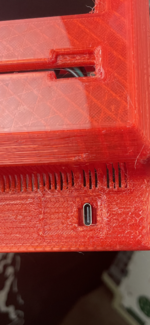The "frame" isn't working exactly due to the crappy implosion band on this set. I don't even think it technically counts as an implosion band, it's worse protection than my DIY band on the first board based on its location. It warps when putting pressure on the glass, so my original measurements where slightly off. That said, it warps enough to work on the "upper frame" (my STL name for it) that connects the CRT to the front "fascia". So that works and the effort of measuring, modelling, remeasuring, remodelling, and repeating paid off big time.
I think there is too much variance in the TVs for me to make one that fits every type, so I think I will just add the final details to the rear case and publish the rear and fascia to share with you all. The rear case just needs the air vents in the handle (I'm being that OCD, why not?— it's a file you press print on), a fake security hole, and the power input / on/off "plate" needs to be made a separate piece like I did with the lower port section. The fascia has m2 holes to interface with a frame that fits whatever TV. People are going to have to model their own internal stuff to fit their components, but at least this one will have the difficult CRT curves the smaller 3.5 inch LCD screen "Mini Macs" lack, so it's something new.
I could probably scale down the fascia a percent or two in order to hide the blackness of the edges of the glass. You might be able to see what I mean in the video, but that also may be an unavoidable effect of the thickness of the glass. If you can find a 5 inch
monitor, it will probably have a darker phosphor, which would look even more like a real Mac.
I'm still waiting for a replacement Pi Zero, although I can test with my pi 4, but it's basically full speed ahead again. The pressure from the implosion band (which also is the main thing holding the glass tube) pulled the m3 screws out, so I've ordered some threaded inserts. I either didn't reduce the diameter of the printed holes enough or I simply screwed them in or out too many times, but threaded inserts should be nicer for repairing the thing anyway. And I can epoxy them, so the plastic fails first.
EDIT: since I'm using this as a bit of a journal for this build; I also need to add the "grooves" to the "handle" on the rear case. Are they grooves, or are they a type of knurling? IDK, I studied advertising.


